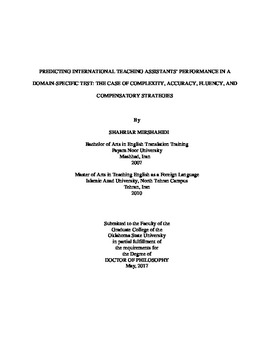| dc.description.abstract | International teaching assistant (ITA) assessment for screening purposes has gained crucial importance with the increase in the number of nonnative speaker graduate students across North American campuses. Although previous studies show that ITA proficiency entails different skills from general oral proficiency, research on its operationalization is rather scarce. Furthermore, while complexity, accuracy, and fluency (CAF) have proven to be reliable constructs to describe language performance (e.g. Ellis & Barkhuizen, 2005; Housen, Kuiken, & Vedder, 2012; Pallotti, 2009), they have not found their way to research on ITA proficiency. Additionally, communication strategies can help ITAs compensate for their linguistic shortcomings. In particular, Halleck and Moder (1995) suggest that employment of compensatory strategies may help ITAs meet the standards that they require in order for undergraduate students to comprehend their oral speech. To that end, more than three hours of ITA Test performances of the candidates at a southcentral university in the United States were videotaped. The ITA Test was an in-house, domain-specific performance test for screening ITA candidates at the university. Using a validated, holistic rubric, the trained raters assigned the performances to three categories of Passed, Provisionally Passed, or Failed. Then, 21 performances were selected and analyzed incorporating eight measures of CAF and two measures of compensatory strategies. The findings revealed that accuracy, when measured by percentage of error-free T-units and number of unintelligible words per 100 words, predicted ITA proficiency. With regard to compensatory strategies, using nonlinguistic means (i.e. visual aids, eye contact, and body language) also predicted the ITA candidates' performance. To sum up, error-free T-units, nonlinguistic means, and number of unintelligible words per 100 words predicted ITA candidates' oral performance when assessed by the ITA Test. Finally, the trade-off effects between the CAF measures (i.e. between accuracy and complexity and between accuracy and fluency) partially confirmed Skehan's (1998) Limited Capacity Hypothesis. Overall, the results can shed light on the role linguistic and paralinguistic features play in predicting ITAs' test performance for both assessment and pedagogical purposes. | |
